Georgia has lovely beaches, cottage-style homes, peaches, and brown recluse spiders. One of these things is not like the other. Brown recluse spiders (Loxosceles reclusa) are one reason people are terrified of spiders and have arachniphobia. Most of what you know about the brown recluse spider is likely false. They are a species that deserves respect, so don’t mess with them. If you toy with these spiders, you will force them to use their only line of defense; biting.
Contrary to popular belief, spiders do not sneak up and bite you. They do not bite because we are a food source or because they like the taste of blood. Nor do they get in your bed and lie waiting for you to get in so that they can bite you. They do not have horrific plans to attack you from behind your toilet or in your shower. Like every living being, brown recluse spiders are simply trying to survive and have the least stress and threats to their lives as possible. Hopefully, this article will help you better understand a severely misunderstood arachnid.
Brown Recluse Spider’s Appearance
Below is the description of a brown recluse spider. Always make sure to look for the fiddle or violin on their cephalothorax (head area). People tend to conclude that every spider they see is a brown recluse, and as you can guess, they are incorrect. One way to combat brown recluse spiders is to coexist with their known harmless-to-human predator spiders.
Size
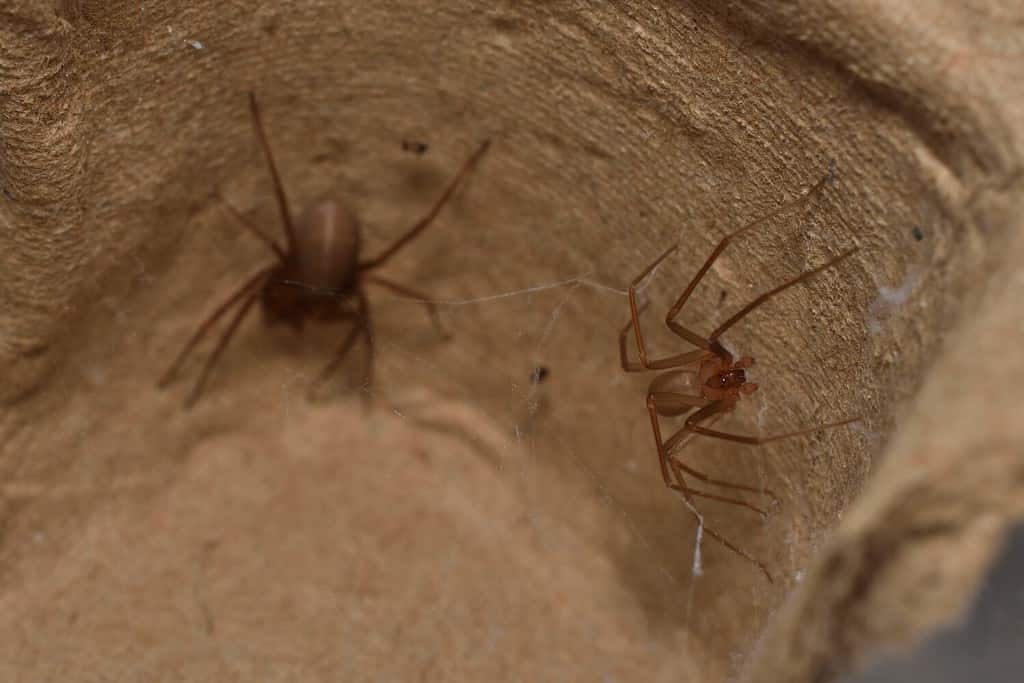
The male brown recluse spider is much smaller than the female but has equally as strong venom.
©Tobias Hauke/Shutterstock.com
Adult female brown recluse spiders are medium-sized with a leg span the size of a quarter and a body length of 1/4 inch. The adult males are considerably smaller, at half the size of the females. When brown recluse spiderlings hatch, they are tiny and must molt approximately ten times before adulthood. All brown recluse spiders are venomous. Their legs are long and delicate-looking without barb-like hair.
Coloring
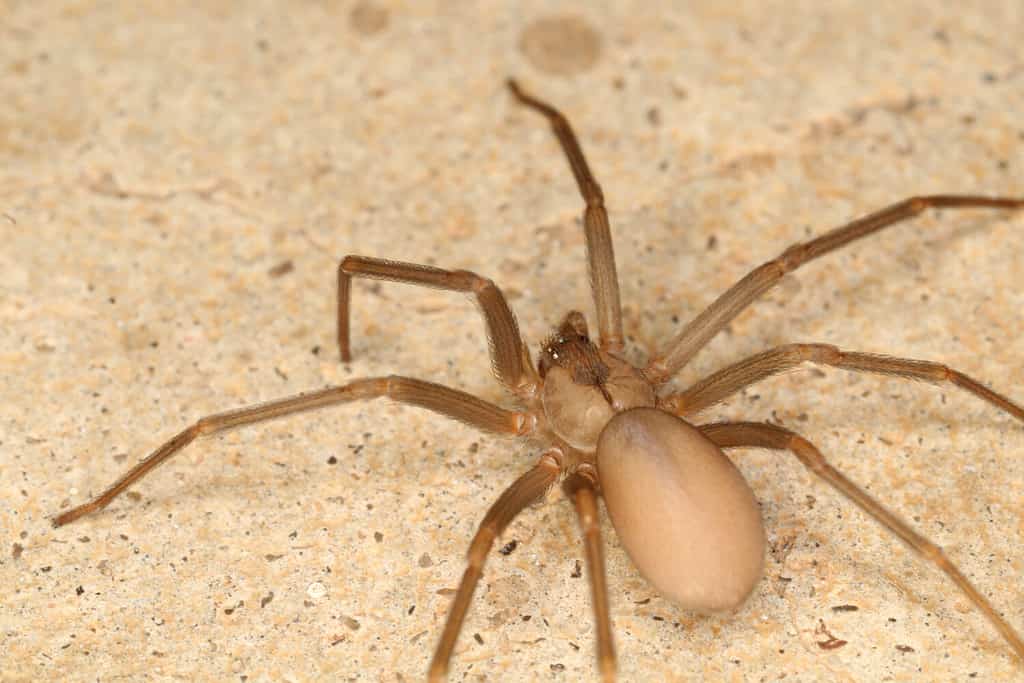
Light-colored brown recluse spider
©Nick626/Shutterstock.com

Dark colored brown recluse spider
©Keith Davis/Shutterstock.com
The coloring of the female and male brown recluse is the same. They have a tan to light brown body with generally lighter tan legs. Sometimes this can vary from spider to spider, depending on their molt status. When a juvenile spider gets near the time to molt, its exoskeleton will darken a bit. Directly after they molt, they are much lighter in color. Still, as their exoskeleton hardens within a few days, their color becomes consistent until the successive molt, which will generally occur in a month.
Fiddle/Violin Shape on Cephalothorax

The brown recluse spider is often identified by the violin-shaped marking on its body.
©Nick626/Shutterstock.com
The best way to know that you are dealing with a brown recluse spider is to note the very obvious violin or fiddle shape they have on their cephalothorax (near their head). In the first photo above, you can clearly see the dark brown fiddle shape. Many spiders look similar to the brown recluse and sadly meet their ends because of such. Some of the look-a-likes actually hunt and eat brown recluse spiders, so be sure to memorize what the brown recluse looks like so you aren’t killing spiders who are there to help. We will talk a bit more about that later.
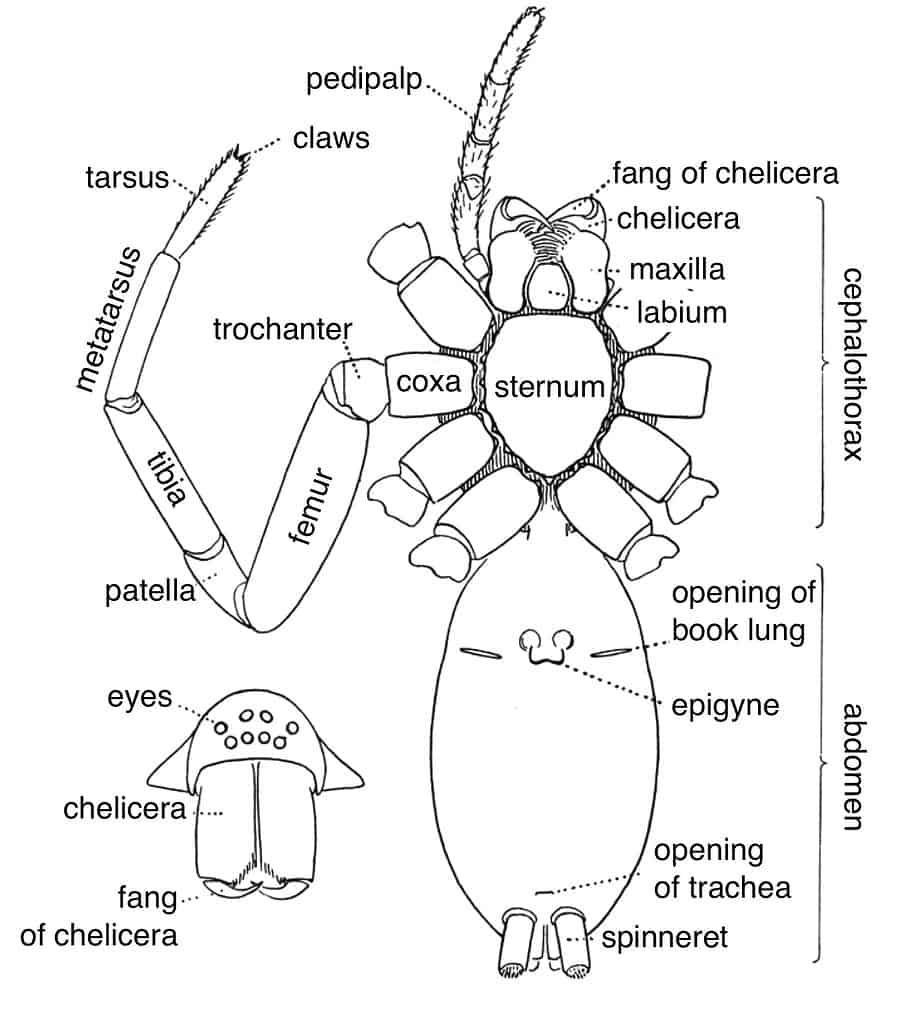
External anatomy of a spider.
©Original: James Henry EmertonDerived: Peter coxhead / CC BY-SA 4.0 – License
Eyes
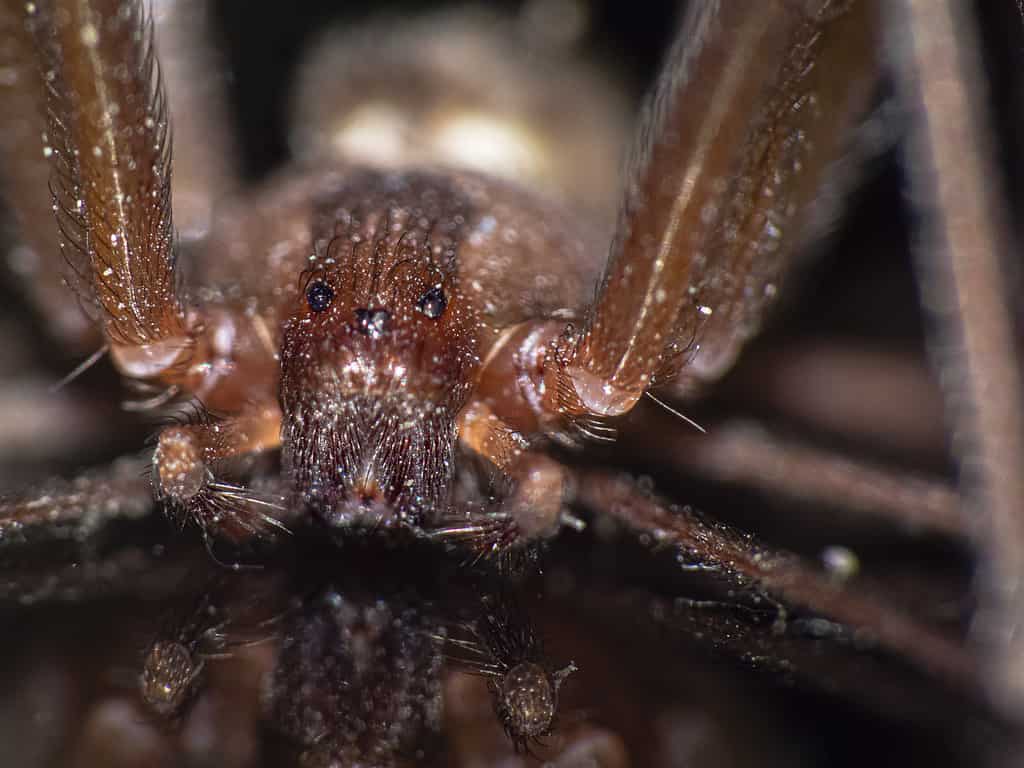
Brown recluse spiders only have six eyes.
©iStock.com/Wirestock
This characteristic is a bit harder to see, but the brown recluse spider is different than other spiders in that it only has six eyes. As you can see in the above photo, the six eyes are divided into three sets, all forward facing on the front of the head. All species of spiders, whether harmless and friendly jumping spiders or beautiful orb weavers, have differently placed eyes. This can identify the brown recluse to the trained eye.
Spiders Who are Mistaken for Brown Recluse Spiders
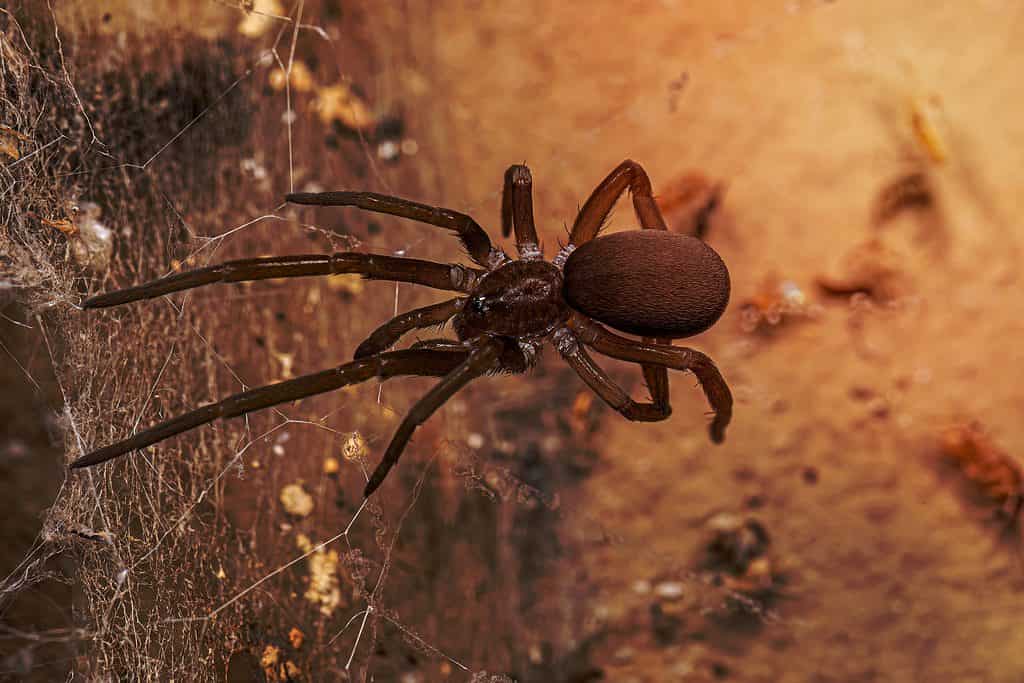
Southern House Spider
(Kukulcania hibernalis)©postolocanu/Shutterstock.com
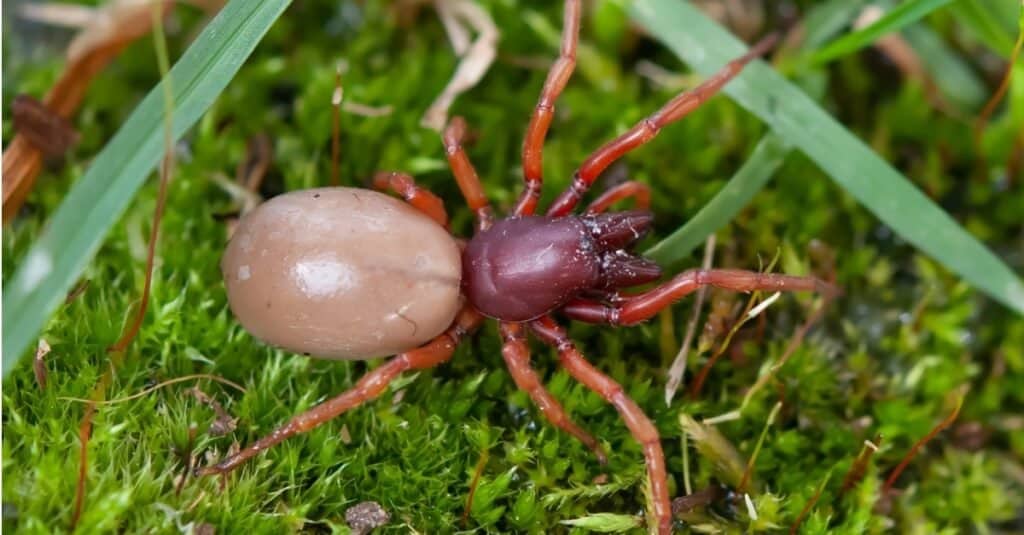
Woodlouse
Spider
(Dysdera crocata)©iStock.com/Uwe Lubjuhn
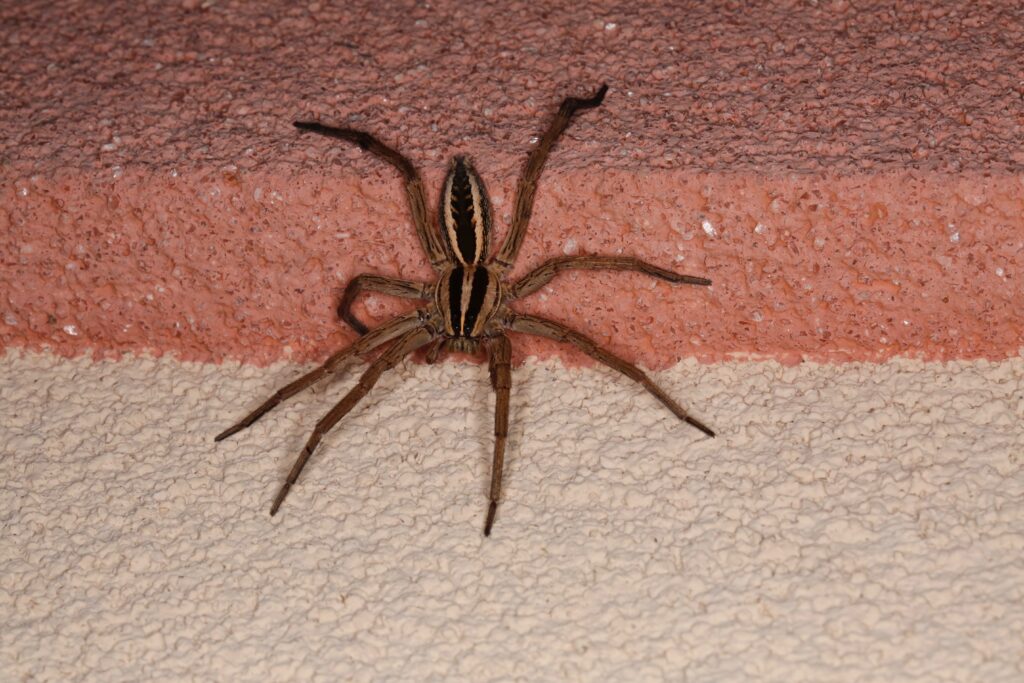
Rabid Wolf Spider
(Rabidosa rabida)©Cathleen Wake Gorbatenko/Shutterstock.com

Long-Bodied Cellar Spider
(Pholcus phalangioides)©Marek Velechovsky/Shutterstock.com
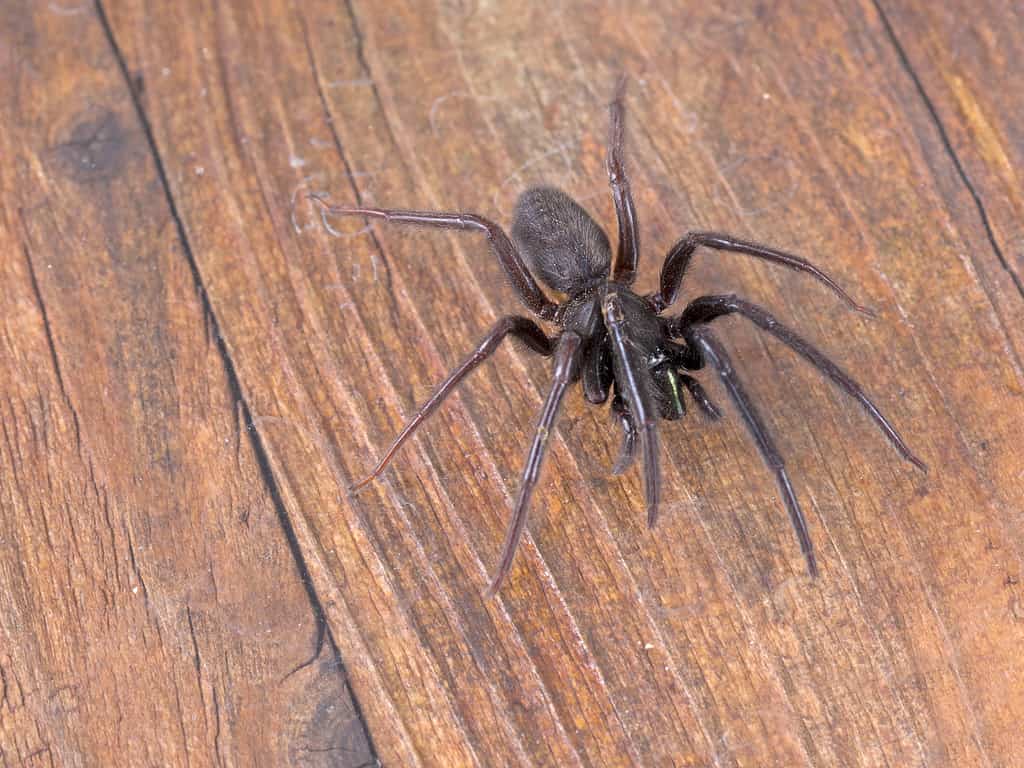
Green-Fanged Tube Web Spider
(Segestria florentina)©iStock.com/Goldfinch4ever
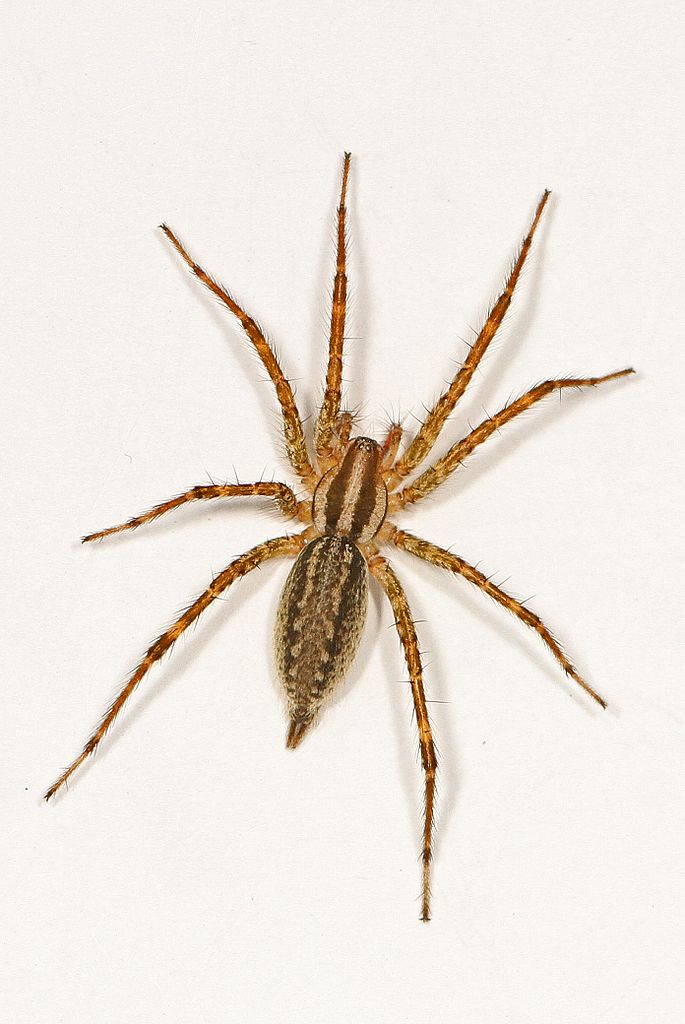
American Grass Spider
(Agelenopsis sp.)©Judy Gallagher, CC BY 2.0 – License
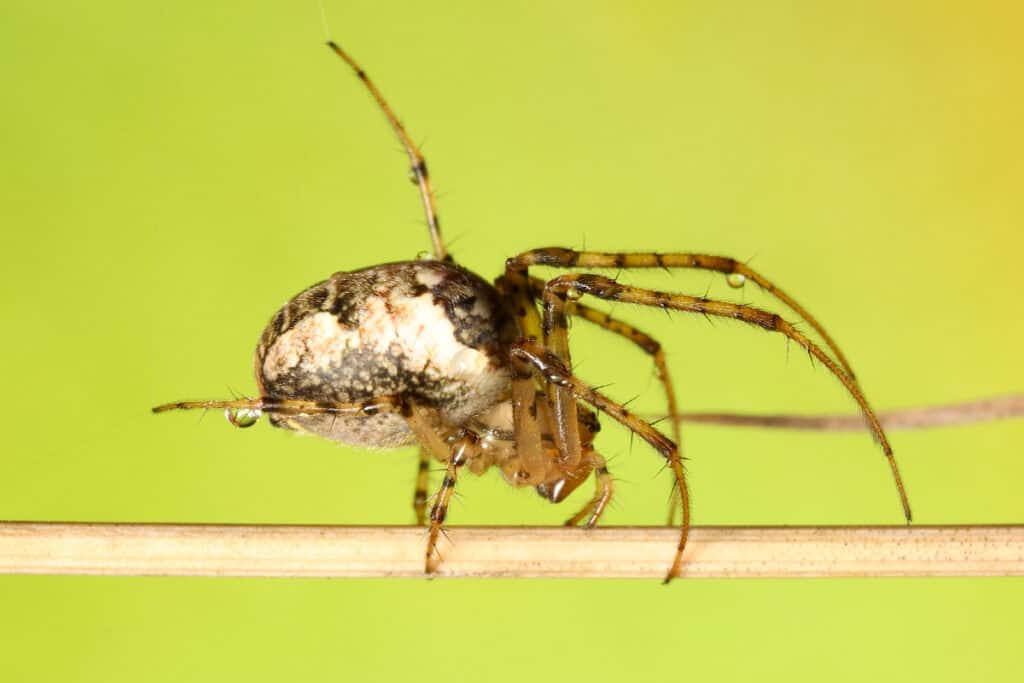
Furrow Spider
(Larinioides cornutus)©iStock.com/Dan Olsen
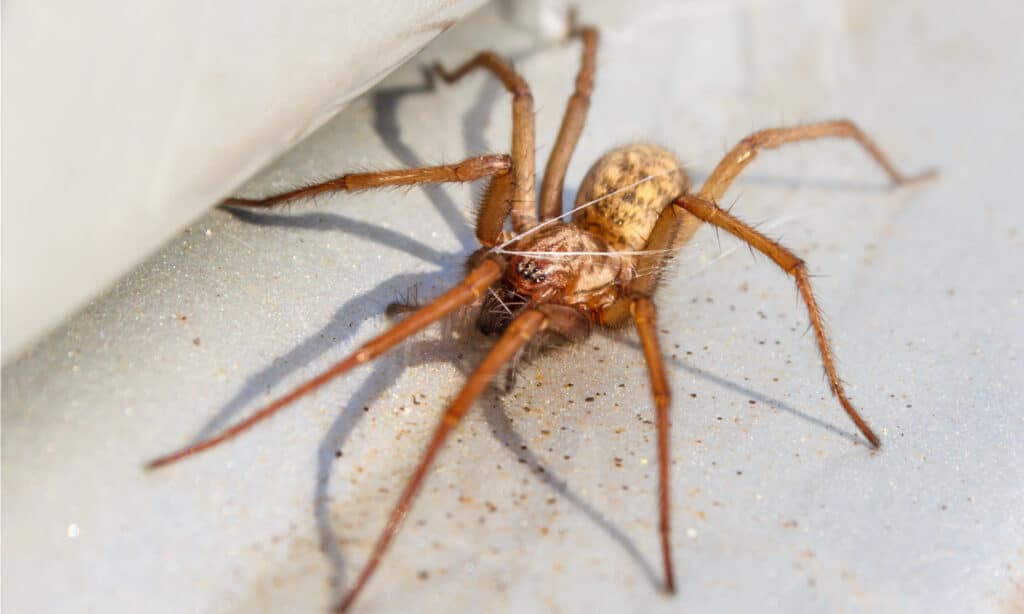
Hobo Spider
(Eratigena agrestis)©Andrew Balcombe/Shutterstock.com

Arizona Black Hole Spider
(Kukulcania arizonica)©Tamberly Conway / CC BY 4.0 – License
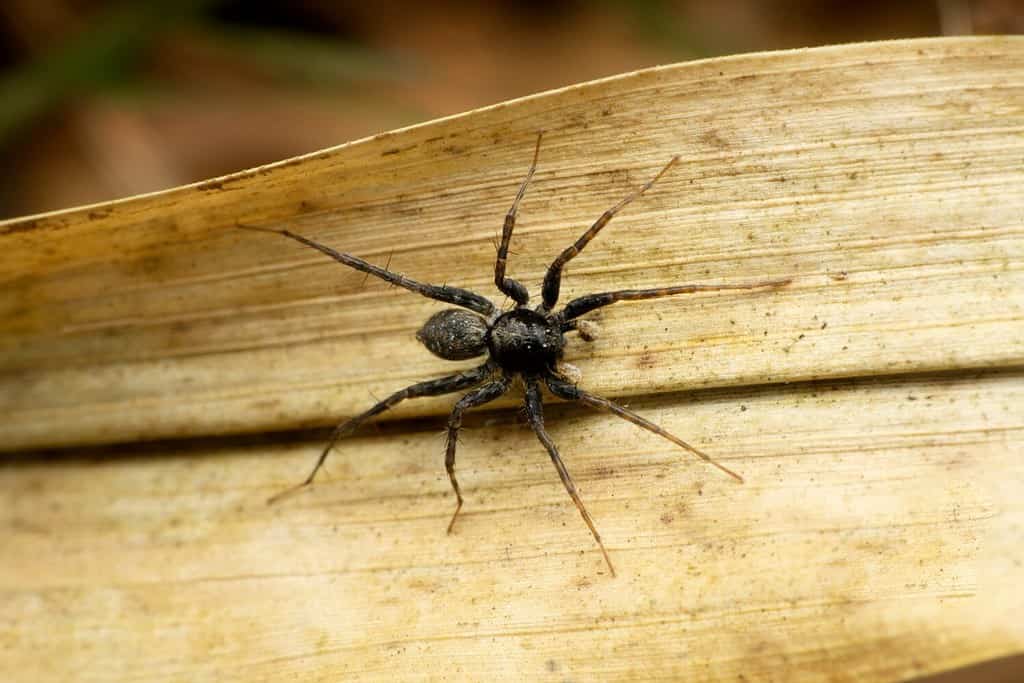
Carolina
Wolf Spider
(
Hogna carolinensis)
©RealityImages/Shutterstock.com
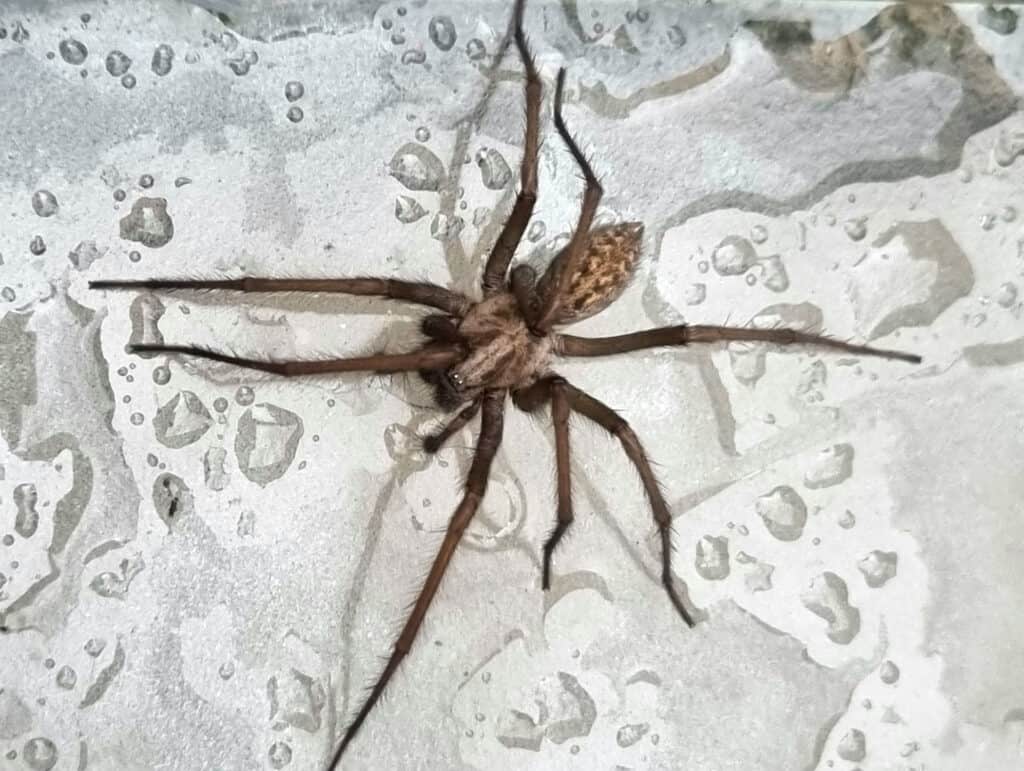
Giant House Spider
(Eratigena atrica)©iStock.com/Kelly McCutcheon
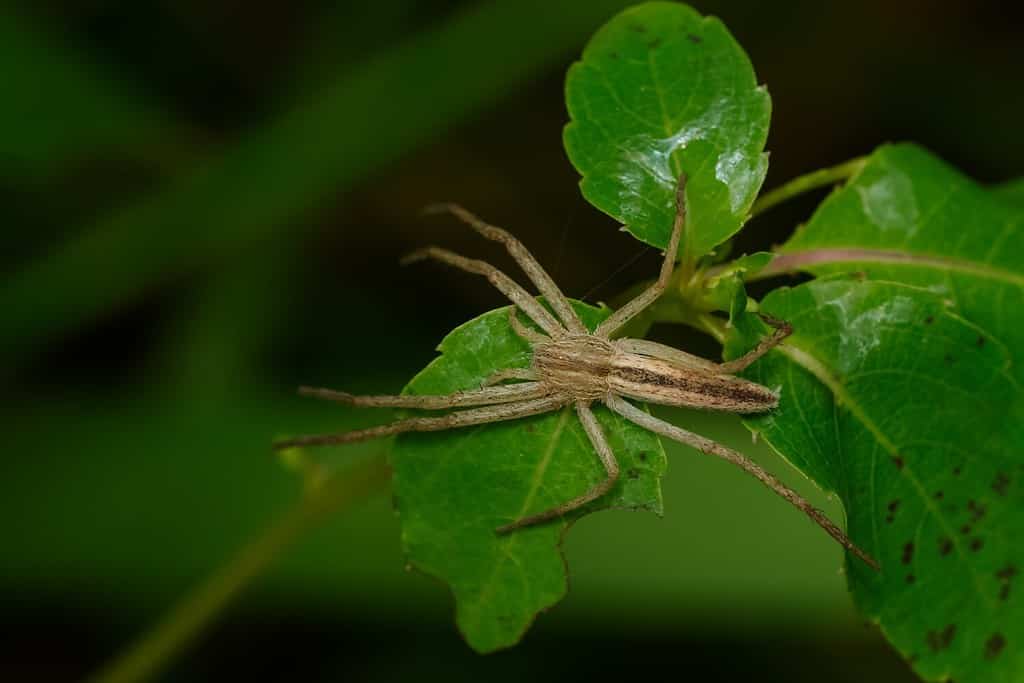
Oblong Running Spider
(Tibellus oblongus)©Paul Reeves Photography/Shutterstock.com
The above photos of look-a-like brown recluse spiders are nowhere near complete. Sadly, most spiders are incorrectly identified as brown recluse spiders to the untrained eye. It is crucial to know what to look for when you see a spider and think it could be a brown recluse. Again, the dark brown violin shape near the head of the spider is the telltale way. No other spider has that marking.
The spider most frequently confused with the brown recluse is the southern house spider (Kukulcania hibernalis) pictured in the first photo above. These harmless and very timid spiders are great to have on your porch because they kill mosquitos, gnats, and flies. The male of the species looks like the brown recluse spider but is missing the violin shape on the cephalothorax. The southern house spider varies in color, similar to the brown recluse.
Brown Recluse Spider’s Habitat
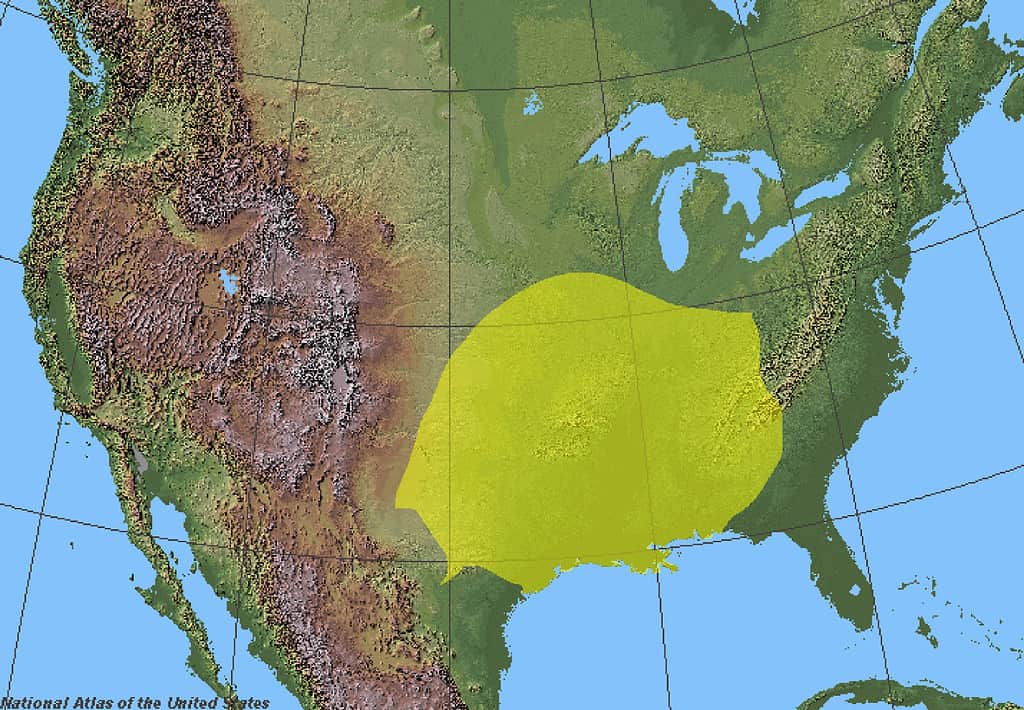
Brown recluse spiders live in the south-central to the eastern part of the United States, as shown in yellow.
©ReliefUSA_map.gif: Public domain, U.S. government. Derivative work: Bob the Wikipedian, CC BY-SA 3.0, via Wikimedia Commons – License
These spiders only live in a small portion of the United States. Their documented range is from southeastern Nebraska through southern Iowa, Illinois, and Indiana to southwestern Ohio. They can also be found in central Texas to western Georgia and north to Kentucky. You can see their general range in the diagram above. Brown recluses are NOT generally found in Georgia, but they can hitch a ride and end up there.
The web of these spiders tends to be sloppily down, low to the ground, and asymmetrical in shape. The web itself includes a sheltered area where the spider sleeps, made of haphazard threads. Brown recluse spiders like to make their webs where it’s warm and dry. Sometimes that means inside your garage, shed, barn, or home. Spiders that come in sometimes live in the bathroom under your sink or behind your toilet. They have access to water when needed, but it is otherwise a safe and dry place.
In the wild, brown recluse spiders like to nest inside rotting trees near the ground, in rotten logs, amongst piles of sticks and leaves, and under other debris. They also commonly nest in cardboard inside your garage, cellar, attic, or home. Sometimes they hide in closets since they choose undisturbed areas with little human interaction. A lot of bites happen when the spider is in its nest, and they are disturbed and feel threatened. Keeping a tidy home can help to reduce the chances of having one of these spiders enter.
Brown Recluse Spider’s Diet
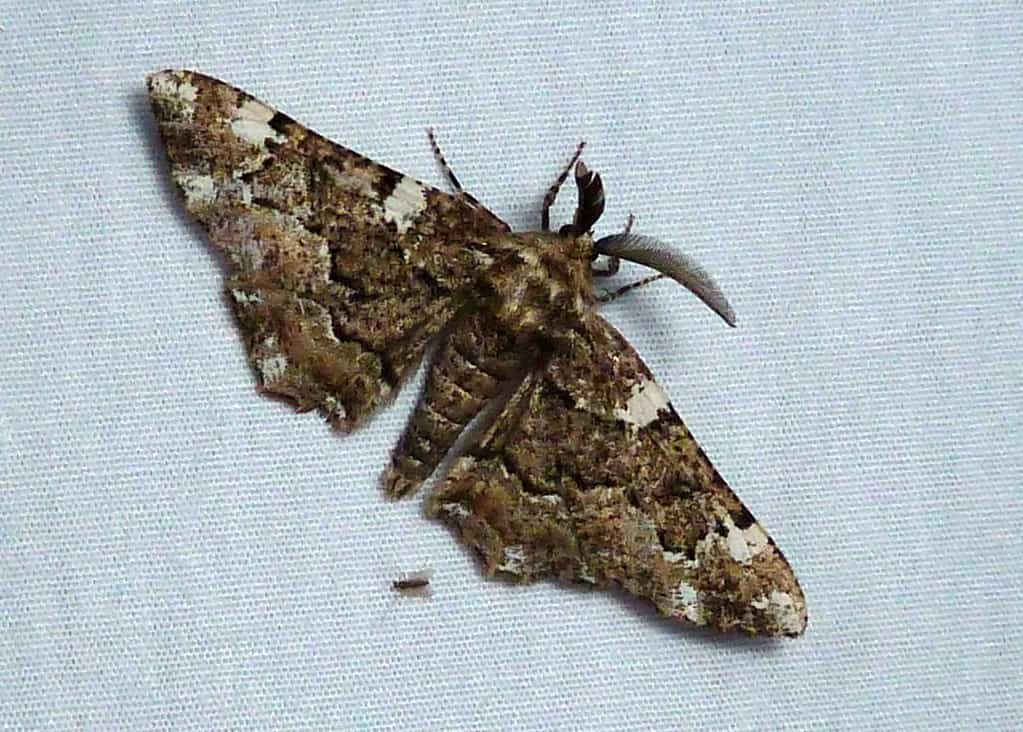
Moths are one insect on the dinner menu for a brown recluse spider.
©Cyndy Sims Parr/Wikimedia Commons – License
The brown recluse spider is nocturnal, hunting during the night. They do not catch bugs in their webs but hunt them by stalking and attacking. Males tend to travel farther from their nest when hunting, with the females remaining close by. They are not picky about what they eat and will even cannibalize their kind or other types of spiders when hungry. When they aren’t being cannibals, the brown recluse eats most insects, like, moths, flies, gnats, crickets, grasshoppers, cockroaches, and other soft-bodied insects.
Spiders, as a whole, do not need to eat daily or even weekly in order to stay alive. When the going gets tough, spiders can sometimes go months without eating. However, they need water several times a week to stay healthy. One way to tell if a spider is fed and watered is the size of their abdomen. When they are hungry, their abdomen will be shrunken and skinny. When dehydrated, their abdomen will look wilted and wrinkled like a raisin but not as severe. If a spider is severely dehydrated or starving, they lose its ability to climb and walk normally and might have twitching legs.
Many types of spiders have book lungs. These are lungs located outside their body on the underside of their abdomen, closest to their sternum. If a spider sits in water or gets wet, it can easily drown because of these types of lungs. Imagine having your lungs on the outside of your body.
Brown Recluse Spider’s Life
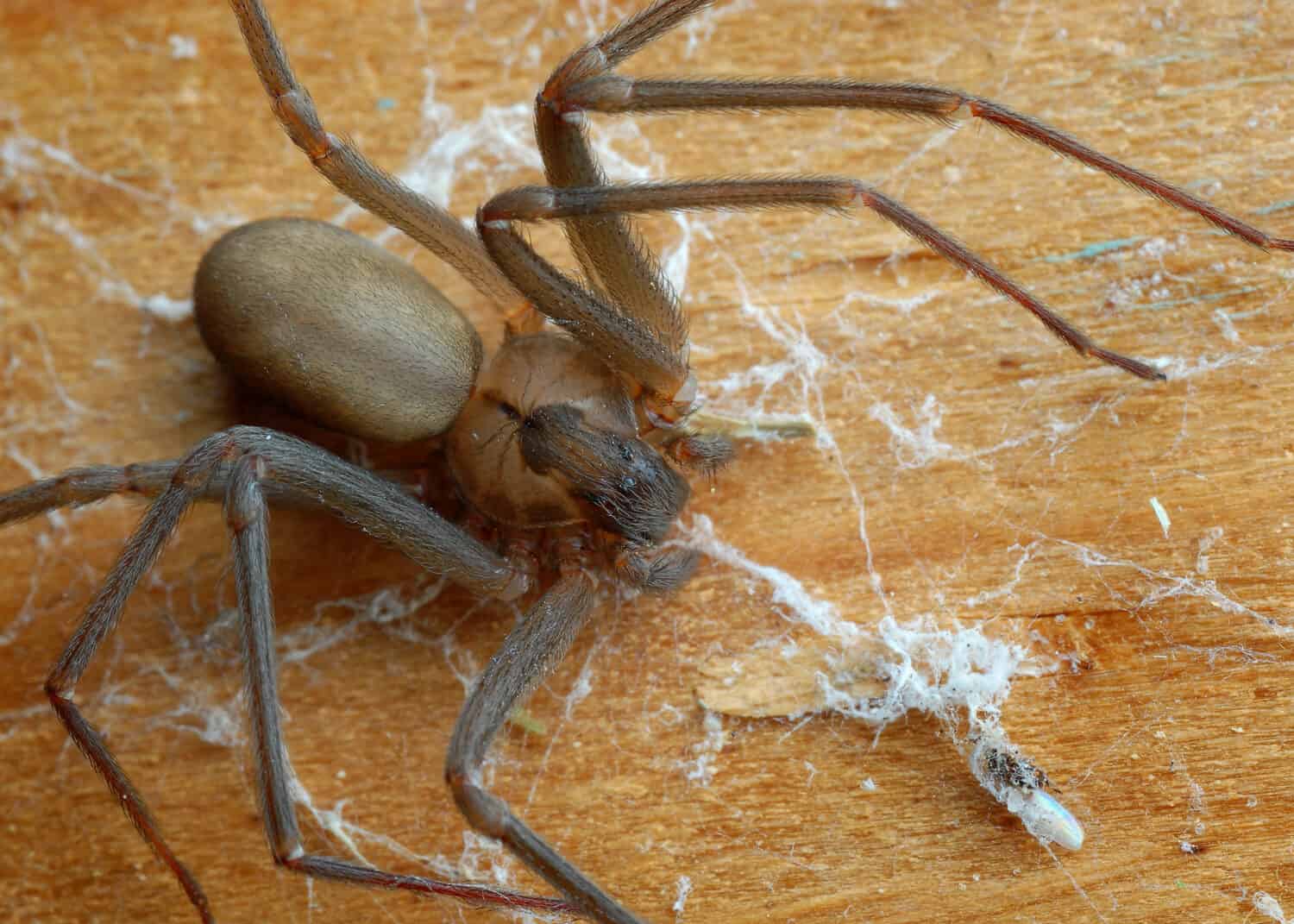
Close-up of a brown recluse spider on a spiderweb-covered piece of cut wood.
©Miles Boyer/Shutterstock.com
Brown recluse spiders are the most active from March to October annually. This is when the temperatures warm up, and the insects they dine on are plentiful. It is also when they are looking for a mate, tending to eggs, and raising their spiderlings. During the cold months, spiders slow down, and if they are outside in the elements, they hide in small cozy nests until the weather is more to their satisfaction.
Generally, a spider will not freeze to death unless they are abruptly transferred into temperatures lower than 23° Fahrenheit, and the temperature stays that way for days. A spider outside all the time will gradually adjust their body to the temperature. As long as the temperature doesn’t fall below 23° Fahrenheit and stays there for weeks, they will be fine. They do not hibernate but instead have a type of antifreeze in their blood that keeps them from freezing. Another way they keep warm is to ride out winter in your home, attic, cellar, etc.
During mating season, a spider can mate and lay an egg sac of 40-50 spiderlings. They will continue to lay eggs an average of five times in their life by storing sperm. They will occasionally cannibalize their mate when they are not interested in the advances or are starving. Mating is generally a one-time occurrence since they can store the sperm and choose when to lay eggs. As with any spiders or insects, only a small percentage of the young will survive to become adults, which is why they have so many in each laying. The young stay with their mom until they are big enough to be on their own and after at least a couple of molts.
What Happens if You Are Bitten
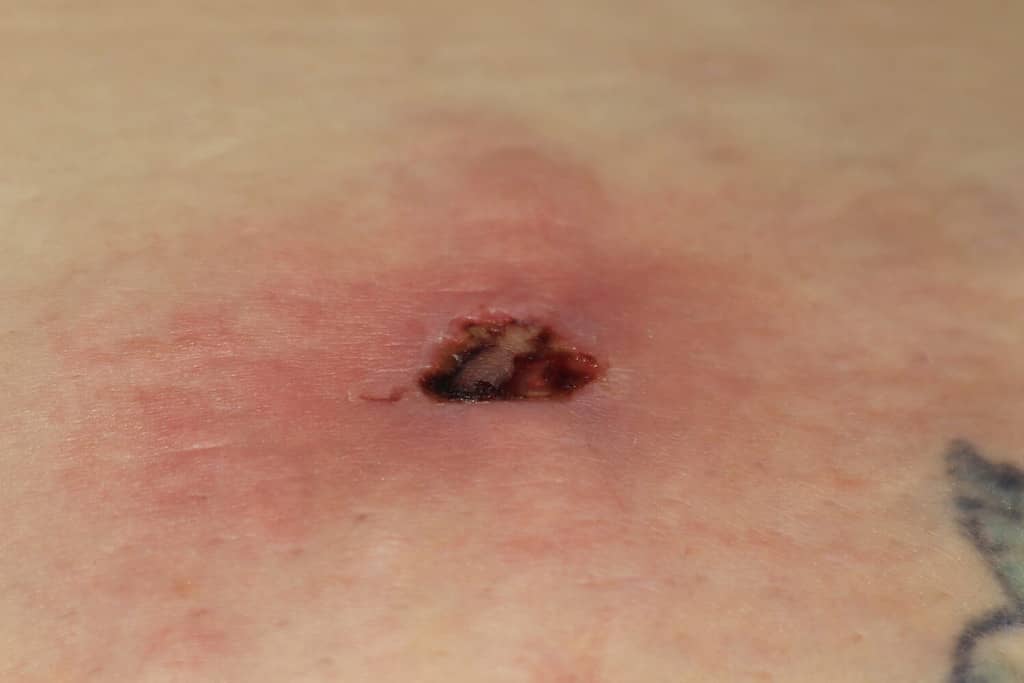
Brown recluse spider bites sometimes cause necrotic wounds to form.
©Robert D Brozek/Shutterstock.com
When a brown recluse spider feels threatened, its first line of defense is to run and hide. They are called “recluses” for a reason, and that reason is that they want to avoid everyone as much as possible. All spiders would instead run than bite. Biting is the last line of defense. Sometimes spiders end up in our beds because they seem like quiet out-of-sight places that stay warm and dry. If the spider gets pinned against your skin and cannot escape, it will probably bite. Another way a brown recluse tries to make you leave them alone is by playing dead.
In 37% of brown recluse bites, skin necrosis occurs. In 14% of bites, systemic illness occurs. If you do experience systemic illness, it will manifest before any type of necrotic skin issues. It will be in the form of nausea, vomiting, fever, rashes, and muscle and joint pain. This affects children, the elderly, and people with other health problems and immune issues much more than healthy adults. Very rarely, bites of this magnitude can result in the development of hemolysis, low platelet counts, blood clots throughout the body, and death. Fatalities tend to happen only to children under seven years old and people with immune issues.
Many brown recluse spider bites are asymptomatic and resolve on their own. Others may become necrotizing ulcers due to soft tissue death within the first week. You will know something is wrong because the bite zone will be very painful, with the pain becoming severe around 36 hours after the bite. The dead tissue becomes gangrenous and eventually sloughs away. The hole left behind can be massive and take months to heal fully. The brown recluse is only able to produce 0.1 microliters of venom at most.
Many types of issues can appear as a spider bite but are not, like MRSA, fungal infections, syphilis, staph infections, and many other causes. This is why bringing the spider to the doctor’s office is so important.
What to Do if You Are Bitten
If you are bitten by what you suspect to be a brown recluse spider, and you see what bit you, put it in a jar and go to the ER, your doctor, or urgent care if you are experiencing uncomfortable side effects. If you have severe symptoms, go to the emergency department. Sometimes it takes three days before a wound is visible, so taking the spider with you is crucial. Not everyone receives venom in a bite, and not everyone reacts to the venom the same way.
When you are bitten, make sure to thoroughly wash the wound with antibacterial soap and elevate it with ice on the wound if possible. You will have two tiny holes when bitten, and it will likely be red around it shortly after the bite. Take a permanent marker and draw a circle around the edge of the redness. Pay attention to how you feel overall, and note if you are experiencing systemic issues. Have a friend or a housemate drive you to the doctor, if possible, in case you begin to experience any dizziness or other symptoms that would make driving safely difficult. If you are experiencing severe symptoms, call 9-1-1 or drive to the emergency department.
Ways to Get Rid of Brown Recluse Spiders
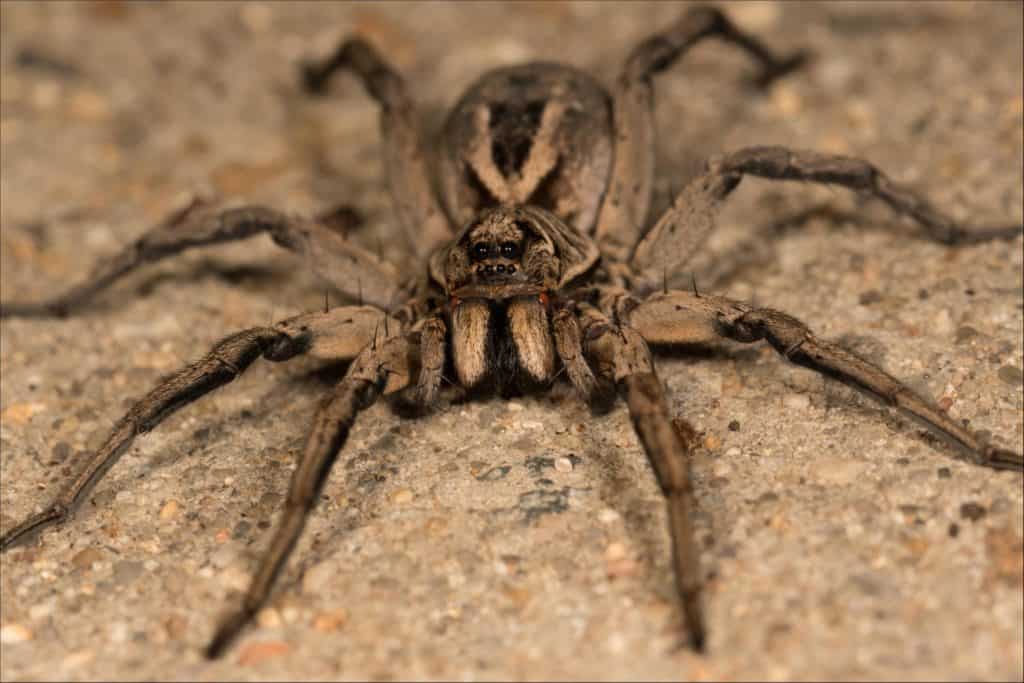
Wolf spiders hunt brown recluse spiders and black widows. They are excellent to keep around and are harmless to humans and pets.
©Katarina Christenson/Shutterstock.com
Before discussing ways to get rid of brown recluse spiders, let’s first talk about how to repel them so they do not come in at all. Essential oils are deadly to spiders. Add mint, lemon, or lavender essential oil to a spray bottle with water and spray all around the edges of doors and windows. Don’t do this if you don’t want to harm the “good” spiders, though. White or apple cider vinegar can also be used as an insecticide and applied around doors and windows.
Some ways to make the uninvited guest see your home as uninviting is by keeping a tidy home, sealing cracks, cutting back bushes and vines from your home, keeping windows closed, and ensuring screens are secure. Do not leave shoes outside; it is the perfect dry place for a brown recluse spider. If you have children’s toys stored outdoors, make sure to keep a lid on them and periodically spray out the bin with vinegar. Dish soap can also work.
Another way is to let wolf spiders take care of the situation. They are known to hunt and eat spiders that are harmful to humans. Wolf spiders hunt them on the ground and do not make webs to catch prey. They are excellent spiders to have around and are also nocturnal, so it’s unlikely you will even see them.
If you have a confirmed infestation, spraying insecticide or calling professionals might be best. Insecticide isn’t just harmful to brown recluse spiders and can harm pets, children, and adults. It’s best to use it as a last resort. Most people live with so-called infestations for years and never have a problem.
The photo featured at the top of this post is © Miles Boyer/Shutterstock.com
Thank you for reading! Have some feedback for us? Contact the AZ Animals editorial team.






